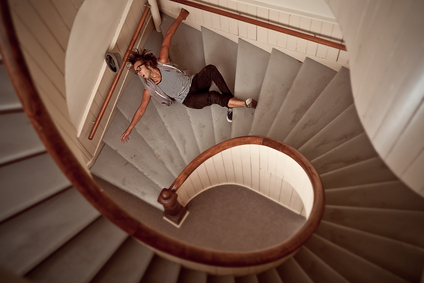
While slip and fall or trip and fall accidents can occur on a variety of surfaces, those accidents that occur on the stairs can be particularly complex. Stairs may present obvious dangers, but there also are hazards that the average person will not discover. Where the cause of the fall is an obvious defect, such as torn, loose, or protruding carpeting or a broken handrail, a victim may prove that the property owner is liable for the injuries that he suffered with relative ease. Materials that spill onto the surface are treated in the same manner as if it were a flat surface and not a flight of stairs. However, there are hidden defects, such as the construction or maintenance of the stairs, which may not be obvious even after the slip and fall accident has happened.
Stairs may have wear patterns that are not obvious, yet pose a serious threat to someone going up or down the stairs. Wear on the very edge of a step, even if it is slight, may lead to a serious accident. In addition, the material that the owner selected for the stairs may present an innate danger. Although highly polished wood or marble is visually appealing, the added risk for users of those stairs may impose liability on the property owner where it would not have existed if a different material were selected.
Outdoor stairs should be constructed of materials that make them safer when there is rain or snow. In addition, there should be an anti-slip surface that minimized the danger from the weather. Although it is true that added precaution should be taken when using outdoor steps in inclement weather, the property owner does have to take reasonable measures to prevent accidents.
One of the often overlooked dangers of stairs is how they were constructed. There are applicable building codes, at both the state and county level, which govern how stairs are to be made and installed. If the section of stairs on which a victim fell failed to meet the relevant code provision, then it is strong supporting evidence that the stairs posed a foreseeable danger. Even a very slight variation from the code could cause or contribute to a serious fall.
The height and depth of the steps, also known as the “riser” and the “run,” are another concealed danger if not constructed properly. Building codes impose minimum and maximum limits on the riser and the run. There also is a variance standard to ensure uniformity between one level of step and the next, which is to avoid an accident when a person automatically gets into a pattern of lifting the foot a specific height. If there is too much variance between the steps, then a person may trip because the mind has been fooled into pacing off the wrong distance. Measuring the stairs after an accident may reveal that there was a deviation from the prescribed lengths that could have led to the fall. Often, this is all that it requires to force the insurance adjuster to make a reasonable settlement offer.
Finally, defective handrails on stairs can lead to severe falls. The problem could be the result of poor maintenance or improper construction, but the result often is devastating injuries.
Many times, a person who falls on the stairs will look around and not see any obvious defect and decide that the accident and resulting injury must have been his fault. This is far from the truth. The experienced slip and fall accident attorneys at Lundy Law understand how to evaluate the site of an accident in order to discover the true cause. Let us help you get the compensation that you deserve with our No Fee Assurance, where you only pay when we win your case for you. To discuss your accident and possible legal remedies, please call us at 1-800-LundyLaw or fill out our free online consultation form.
















